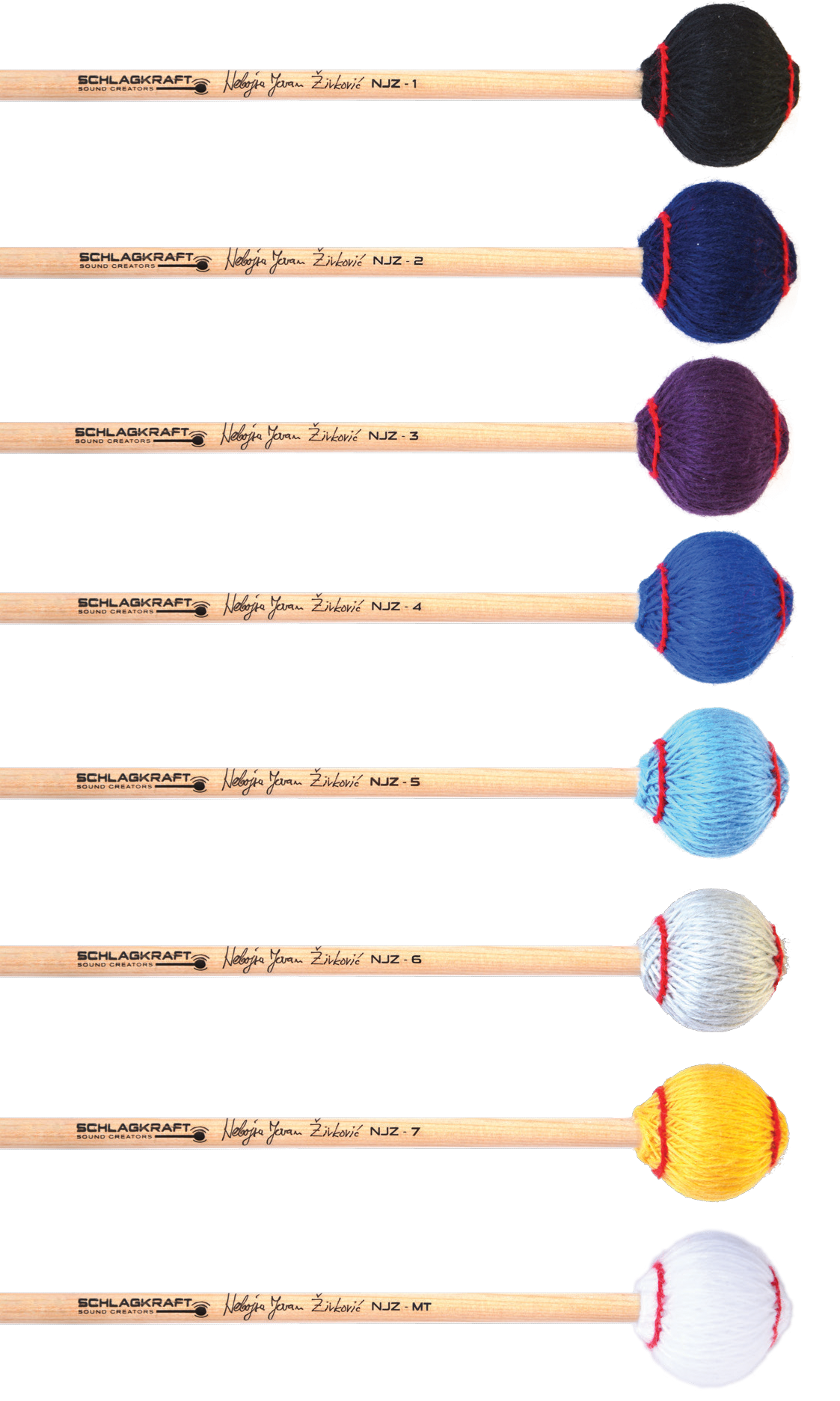BECAUSE SOUND MATTERS…..
NEW Nebojsa Jovan Zivkovic Signature Mallets by Schlagkraft!
Check My New Series Here
Purchase Mallets from your local dealer or online
Nebojsa Introducing his Signature Marimba Mallets
I may say, I am very serious and picky when it comes to mallet choice. Maybe for some of you this text is too long. IF you lack the appropriate PASSION and TIME for this, please just keep surfing somewhere else. This page is for people who are seriously interested in mallets and ARE concerned about searching for the best possible sound on their instrument.

TALKING ABOUT SOUND…
The marimba sound I am looking for could be described as clear, very sensitive, in most cases slightly sharp rather than too cloudy (moody), but never harsh or hurting. Also, even in the softest pianissimo (even with the softer mallet), one should be able to get a clear attack, to hear a distinct beginning of the vibrating bar, with almost no contact sound between the mallet head and wooden bar.
At the same time, in order to get rich fundamentals, especially from the LOWER register of the marimba, where the bars are rather big, we need to have mallets with certain weight and length. (weight and length are the things responsible for what is later called “good balance” or “good feel”). Having a certain MINIMUM weight, the mallet will almost “alone” be able to get a rich sound from the instrument, and there will be no need to spend any extra energy by the performer (in terms of stroke).
This “size & weight thing” however, can not be endless, since the mallet will simply become too heavy and large. With such mallets we hardly are able to perform anything but rolls or slow easy lines of single notes.
On the other hand, I also need a mallet that is strong and powerful enough to CUT THROUGH the full symphony orchestra in marimba concertos, even if the orchestration is rather “thick”. It is a challenge to get mallets that are HEAVY enough to help produce a FULL, RICH sound – yet at the same time are LIGHT enough (and well balanced), so that fast runs, virtuoso passages and fast interval changes are playable.
So, the ideal combination of HEAD SIZE, SHAPE and WEIGHT, shaft LENGTH, and additional layers and wrapping (material, layers and tension of the wraps) FOR EACH MODEL AND HARDNESS had to be found, while always keeping in mind what the MOST COMMON USE of each specific mallet will be.
EMOTIONAL LEVEL…
I strongly believe that one must LOVE his mallets, and not merely the “feel” and sound…
You must love the view when you open your mallet bag, you must love the SMELL of the wood you have on the new mallets, you must love TOUCHING the shafts, you must love HOLDING them, you must love how they look- their wool and colors, and you must also love the “rebound” they give you when you play with them. You must respect and tolerate all those small differences they will have due to different layers around the head (various materials and various thickness)…and as they get old and beaten up, with various dents and possible sound changes, you must love it, and live with that too. My mallets are my FLOWERS and my GUNS at the same time –
I smell them and kiss them and use them for a “fight” when needed.
My mallets are made to last LONG! You will spend YEARS with them before they loose “hair” (wrapping)…they are not designed for a “6 weeks relationship” like many other mallets out there…so you better make sure to really treat them well!
Was this too much for you??? My friend Ben said, “bit over the top”. Well, there is no “top” when it is about EMOTIONS… OK???
However, the next paragraph is less “esoteric”, more profound and “down to earth”, so you might enjoy that one more…

PHILOSOPHY and MODEL DESCRIPTION…
NJZ-mallets must be strong and powerful, yet with excellent sound and response in pianissimo playing. They must react immediately to the smallest movement of my hand or fingers, and they must PROJECT clearly and strong through the orchestral forte in concertos.
It also must be the ultimate mallet (well, this for sure, one must play ULTIMATUM1 with it::)) that can stand much “beating” and rough treatment without falling apart after a few SLAVIC EMOTIONAL ERUPTIONS. Understand?
While some people might argue which is better: WOOD or RATTAN for the shafts; and offer the mallets in ONE preferred material only, I have all my models available on BOTH shafts. You can select and order them either on oversized wooden shafts, or on high quality RATTAN (also slightly thicker than most other rattan shafts)
I produce both versions wood AND rattan. So every performer can select what he likes depending on his grip and taste. For example, I play only with WOOD when performing with four mallets and almost always with RATTAN when performing with TWO mallets.
I have EIGHT DIFFERENT MODELS for various performing situations, starting from “earthy black” (soft, no.1) and ending with a strong-clear sound (canary yellow, cut trough no.7). The eights model is a MULTI TONE model, (two-tone with smooth sound change).
First I did not want a two-tone mallet, but later I discovered that I AM able to produce a VERY COOL multi-tone mallet, (that will not become “stone-hard-single-tone after 4 weeks) So, I decided to add it to my family. This one is called NJZ-MT and has white wrapping.
Basically, my signature mallets are separated in THREE SOUND GROUPS, plus one Multi-Tone mallet:
– Group one: DARK, EARTHY, SOFT (models NJZ-1 and NJZ-2).
– Group two : GENERAL PERFORMANCE, tender to clear (models NJZ-3, NJZ-4 and NJZ-5).
– Group three: STRONG. SHARP, CUT TROUGH (models NJZ-6 and NJZ-7).
– And: MULTI TONE MALLET, gradually changing from softness of approx. NJZ-2 in piano to hardness of NJZ-6 in forte dynamic.

My softest model (NJZ-1) is definitely not so soft as a marimba mallet COULD be – not only because I personally do not enjoy that “killing me softly” sound, but also because I believe that the softest mallet should do MORE than just hit and produce a few endlessly soft notes (but besides that be absolutely useless). What I wish to say is, with my model no.1 you can actually play marimba in many different situations. Model NJZ-2 is a bit clearer in sound, still good for nice rolls, but with a distinguished touch.
On the “hard side” of the sound, I also have put a border line earlier than most other mallets that I have checked. You will be able to find many HARDER models than my hardest one (NJZ-7) because I no longer enjoy playing marimba at triple forte in a concert and feeling PAIN in my ears. My “hardest” model, NJZ-7 will have more BODY and a RICHER sound than any other mallet I know of, and will still cut through the orchestra in ANY hall, without hurting anyone. This way I will have no limit in terms of the power of my performances, except those of my own physical condition :-). NJZ-6 is also in this “sharp/cutting” group, but it is a little less hard.
I love NJZ-6 in strong movements with orchestra – for example, the 3rd movement of my second marimba concerto. However, for the very ending of that movement I would switch after the cadenza to NJZ-7.
Now to the most important and most often used group of mallets: GENERAL (medium group). For me it is important to have MORE SOUND OPTIONS with FINE NUANCES in that all-important “medium” range. My models NJZ-3, NJZ-4 and NJZ-5 are three general models that I believe will satisfy anyone’s needs. Model NJZ-3 is a general but tender mallet, that will be very good for the slightly softer side of the general sound. It also can be combined easily as a bass mallet in combination with model NJZ-4. It is heavy and strong enough to get a good sound from ALL registers, but not too heavy – so it can be used in fast runs and powerful single/combined lines as well.
However, in most cases I would spontaneously first pick the model NJZ-4 from my mallet bag before I listen to see if any mallet changes are needed due to hall and acoustic circumstances etc…
NJZ-4 is just slightly harder than NJZ-3 and it is THE general mallet for me when using a 5-octave instrument in solo performance. (If you are an orchestral player that plays marimba in the percussion section for a contemporary orchestral piece, I would recommend to first try NJZ-5) I always try NJZ-4 for ULTIMATUM and ILIJAS first, and than decide if I have to switch to NJZ-5 or to combine NJZ-3/4 or NJZ-4/5. Btw, my mallet combination for those two pieces is mostly 4-4-4-4, or 3-4-4-4 or 4-5-5-5.
NJZ-5, – the hardest from the “GENERAL” group, has a clear sound and carries very well through large halls – but it also produces a clear FUNDAMENTAL (and not only the overtones as most other “medium-hard” mallets do).
I love playing contemporary Japanese (and similar non-Japanese) pieces with them.
ALSO , model NJZ-8MT is for music where soft rolls as well as hard runs and sfz accents are requested, like in many contemporary pieces. There is worth trying my NJZ-8MT MULTITONE.
This multi tone will NOT be too soft in piano and also will NOT be too hard in fortissimo. and best of all, in difference to most other “multi tone ” and “two -tone” mallets I have experienced during my education, this one will NOT became STONE-HARD-ONE-TONE after one month of intensive playing…. (this, along with a poor sound quality due to light heads, is the problem nr.1 with all two-tone mallets)
Well, hopefully this was enough explanation. I purposely did not include the weights and measurements of the mallets. Those who love them do not need the measurements, and those who DARE (hee, hee) to try to copy my mallets will measure everything by themselves anyhow.
Please see the mallet chart below for a short overview.
Model Nr. |
Name & Color | Description / Usage |
| NJZ-1 | Earthy Black | Soft
rolls and lines in lower register, full-bodied sound, tender
but always clear and never too moody. This is NOT a choral-cloudy mallet |
| NJZ-2 | Ocean Deep Blue | Same group as the nr.1 model, but with more distinguished touch, slightly clearer projection. Fits well as a top line mallet in combination with model nr.1 |
| NJZ-3 | Lilac Tender General | Of
my 3 GENERAL models this is the tender one. Ideal for
strong, resonant sound, but still without any
harshness. Produce clear lines and still deliver beautiful rolled chords. |
| NJZ-4 | Blue Strong General | Nr.4 is the standard mallet for general performance that covers all registers of the instrument and produce strong, clear and powerful sound. |
| NJZ-5 | Sky Blue General Clear Cut | Never too hard, but always VERY CLEAR and strong, ideal for strong contemporary and expressive performance, still some tenderness in piano, very good with orchestra. |
| NJZ-6 | Silver Sharp | Prefer the HARD side of the sound? This is your mallet than. Head still enough big to pull out all fundamentals and bring them to the last row in any concert hall. |
| NJZ-7 | Canary Cut Through | It
is always a challenge to get a strong, cutting edge sound that
has volume, some grease, and the ability to cut through the accompanying
ensemble or orchestra. NJZ-7 does that! |
| NJZ-8MT | Sky white | This is the best mallet for contemporary pieces where soft rolls and hard intensive strokes are requested. Release one year later than all other models because it took LOOONG time to made what I was looking for. This mallet will NOT be "stone hard" after 4 weeks and will NOT be "ultra soft" in piano.. It is mallet for GENERAL performance that fits tender rolls and, - from FORTE above - also get hard accents. soft like my NJZ-2 and hard like NJZ-6. Check it out! |

